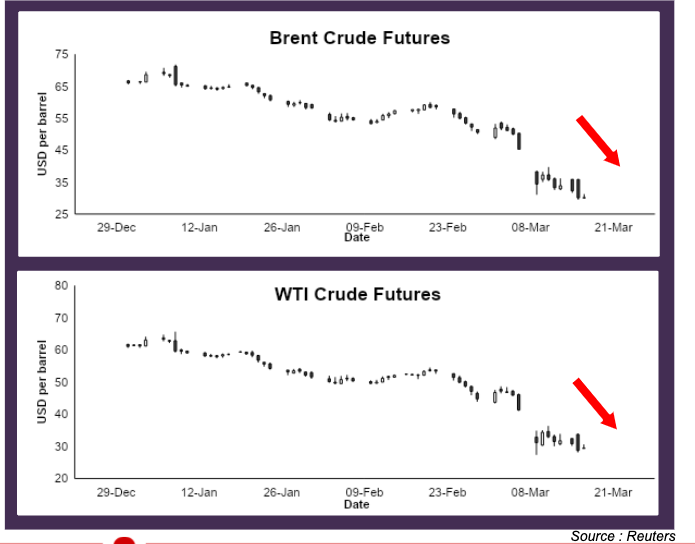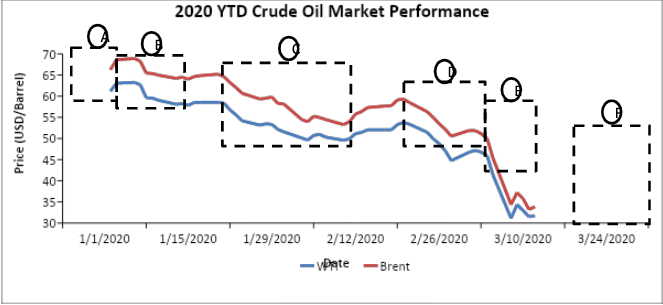Crude Oil Spotlight : Oil Tanked and It’s Spilling Over

Prepared by Aron Liew, CFA, and Zainal Aiman
On the first Friday of March in Vienna, a beautiful time where Austrians are waiting for the end of winter and yearn for the start of spring, a very important meeting between OPEC members and Russia was being held behind closed doors. Minutes after the meeting concluded, crude oil prices plunged, sending shockwaves to the market. Traders all around the world, who were scrambling to cope with the impact of COVID-19, suddenly had another issue barreling through their trading ideas.
Crude oil prices plummeted around 10% on the Friday itself and when trading resumed on Monday, prices opened with a wide gap down. Crude oil prices were crushed even more and ended the day badly bruised, down another 24%. Oil and gas related counters and other oil commodities, including crude palm oil, also tanked. Dollar also took a beating and the Malaysian Ringgit also depreciated.


A Closer Look on 9 March Oil Price Crash
A New Global Crude Price War?
- 9 March 2020 represent a historic moment in crude oil market when oil prices suffered their biggest daily fall in nearly three decades in the wake of Saudi-Russia oil price war.
- Brent crude futures fell 24.1% to settle at $34.36 per barrel, while the US West Texas Intermediate (WTI) crude oil dropped 24.6% to end at $31.13 per barrel.
- This was the first time oil prices experienced their largest daily price decline since 1991 when American forces launched air strikes on Iraqi troops following their invasion of Kuwait
So, what just happened?
- Since 2016, Saudi Arabia and Russia agreed to form OPEC+ alliance after oil prices plunged to $30 per barrel.
- Since then, the two leading exporters have orchestrated the production cuts of 2.1 million barrels per day.
- In light of the weaker consumption due to the coronavirus outbreak, Saudi Arabia wished to lead OPEC and its allied producers including Russia to make deeper cuts to oil production to stabilise the oil market.
- However, on 6 March 2020, Russia has refused to join OPEC further on steep supply cut as they believed it will only lead the US shale oil production to keep expanding and hence, strengthening their position in the global crude market.
- On top of that, their energy minister, Alexander Novak signalled a fierce battle on market share when he said countries could produce as much as they please from April 1.
The beginning of Oil Price War

- In retaliation, Saudi Arabia over the weekend cut its official selling prices for April for all crude grades to all destinations by between $6 and $8 per barrel in an attempt to punish Russia.
- It was also reported that the Kingdom is looking to raise its daily crude output by as many as 13 million barrels.
Source : CNN News and CNBC
The Oil Production Cut Timeline (2016 – 2020)

How to Navigate the Crude Oil Market Moving Forward?

- International Energy Agency (IEA) has already lowered its annual forecast of oil demand by 1 million bpd, the first time demand will have fallen since 2009 due to the coronavirus epidemic and the crude price war.
- So far, three (3) North American oil producers has slashed their capital spending and drilling plans as crude prices tumbled and pressure on businesses intensified.
- KIBB foresee that crude oil prices will be severely affected by the recent developments, hence 2020 average Brent crude oil price is expected to hover around USD40 per barrel.
- However, a market price correction might occur later in H2 2020 as the prolonged low oil price environment could see a reduction in shale production, leading to a slight rebalancing of the market’s demand and supply dynamics.
- In addition, with Russia’s fiscal breakeven oil prices reported to be circa USD42 per barrel, Russia may return to OPEC’s negotiation table.
Source : IEA and Kenanga Investment Bank Berhad
A Quick Recap Of Crude Oil in 2019



What Causes the Crude Oil Market Volatility in 2019?
Oil prices have become volatile in 2019 thanks to the unexpected swings in the factors affecting oil prices


How’s Crude Oil Market Performance So Far in 2020?


How’s the Crude Oil Market Will Perform this Year?

Positive Indicators

Middle East Geopolitical Unrest
In January 2020, the killing of Iran top commander elite force escalated the friction between Iran and the West to new heights. Any conflicts in Middle East especially in Iran have greater impact to the crude prices as the region plays an important role in global oil supply. Although the conflict has already de-escalated, many analysts foresee the situation in Middle East to return to chaos at anytime which will eventually drive crude oil prices higher amid the concerns on supply disruption.

Expectation of Weaker US Dollar
Many analysts expect the greenback to face some challenges and risk this year amid the growing global uncertainties that brought back the recession fears. A recession concern would force US Federal Reserve to cut rates aggressively and that would weigh on the US dollar. At this point of writing, the Fed had slashed its benchmark interest rate to near zero and promised to boost its bond holdings by at least $700 billion. Meanwhile the Trump administration is also proposing a fiscal stimulus of up to USD1 trillion.
Factors to Watch in 2020
Potentially Negative Indicators

Coronavirus Outbreak
Coronavirus, or better known as COVID19 was first detected in late December 2019 and had quickly spread across the mainland China and around the world. The number of deaths and infected cases have now exceeded those of the SARS outbreak. Worries over potential global economic fallout due to this virus will undoubtedly affect the global crude demand as well.

Potential Global Economic Slowdown
In their latest Global Economic Prospect and World Economic Outlook report, both World Bank and International Monetary Fund(IMF) had slashed their 2020 global growth forecast to 2.5% and 3.3% respectively, citing the rising geopolitical tensions, intensifying social unrest and slowdown in emerging markets as factors. With the emergence of the coronavirus that is spreading across the world, the possibility of further downgrading of global growth is likely to occur, which may lead to a decline in global energy demand.

The Saudi-Russia Oil Price War
OPEC and its allies including Russia have been trimming production for most of the past three years in an attempt to offset a surge production from the US shale industry. Unfortunately, their deeper production cut talks amid the coronavirus outbreak collapsed in early March as Russia refused to join the agreement. In retaliation, Saudi Arabia began the oil price war by slashing the crude oil prices to its importers. This situation would severely impacted the global crude oil prices as both nations are major oil producers

Prospects of Prolonged US-China Trade War
The long-awaited phase one trade deal signing ceremony between US and China in mid January this year has at least brought some calm to the global financial and stock markets. However, most analysts foresee that the friction between the two world largest economies is not over yet as there are still so many uncertainties ahead with both nations has not removed all the tariffs to each other.
The Impact of Coronavirus Outbreak (COVID-19) on Crude Oil Price
Coronavirus is a respiratory illness that was first identified during an investigation into an outbreak in Wuhan, China. They are a large family of viruses which also includes Middle East Respiratory Syndrome (MERS) and Severe Acute Respiratory Syndrome (SARS). On February 11, 2020 the World Health Organisation announced an official name for the 2019 coronavirus outbreak as COVID-19.
Source : Centre for Disease Control and Prevention (CDC)
Short Timeline


What are the impacts to crude prices so far?
- Oil prices fell dramatically in mid-February, but had been steadily climbing back as the number of new cases of the virus in China slowed.
- In the last week of February, however, reports of the spreading virus knocked prices down. The benchmark for U.S. crude oil fell 16% during the week, settling at $44.76 a barrel. Brent crude, the international standard, dropped 14% for the week to its lowest levels since July 2017, closing Friday at $50.52 a barrel.
Source : Bloomberg
What to expect next?
- While the impact to the crude oil prices are alarming, many analysts expect the outbreak should not significantly dampen the global oil demand growth in the long term due to several key factors :
1. A Shrink in Global Crude Demand in Near Term
- According to outlook by International Energy Agency (IEA), the global oil demand is expected to contract by 90,000 bpd to 99.9 million barrels per day in 2020 amid the outbreak.
- he impact is largely attributed to the potential lower oil demand in China, which is the world’s second largest oil consumer, on the back of lower economic activity.
2. A Temporary Impact on Oil Prices

- Despite the pressure of price amid the slam in oil demand, the oil market is expected to move towards balance in the second half of 2020 despite the recent oil price war.
- This is due to the potential of market correction as both Russia and Saudi Arabia are expected to return to the negotiation table once the crude oil prices breached their breakeven oil prices.
Source : International Energy Agency and Bloomberg
Why you Should Hedge Now?
- Whether you are a producer or consumer of crude oil, you are exposed to price volatility and uncertainties.
- Lack of stability and predictability in both crude oil and currency movements in recent years has impacted the profit margin of companies.
- Heightened concerns arisen from the emerging trade barriers, geopolitical uncertainties, supply & demand among others will continue to bring greater uncertainty into the market.
- To manage your price risk exposure and protect your profit, HEDGE!
About CME Group
- The world’s leading derivatives exchange offering the widest range of global benchmark products across all major asset classes in the derivatives marketplace.
- Comprises four (4) exchanges; Chicago Mercantile Exchange (CME), Chicago Board of Trade (CBOT), New York Mercantile Exchange (NYMEX) and Commodity Exchange Inc. (COMEX).
Hedging Opportunities on CME Group

Thank you for reading.
Please visit our website : www.www.kenangafutures.com.my for more reading material.
Download full article here
Disclaimer:
This document has been prepared solely for the use of the recipient. No part of this publication may be reproduced, stored in a retrieval system, or transmitted in any form or by any means without the prior written permission from Kenanga Futures Sdn Bhd. Although care has been taken to ensure the accuracy of the information contained herein, Kenanga Futures Sdn Bhd does not warrant or represent expressly or impliedly as to the accuracy or completeness of the information. This information does not constitute financial or trading advice; neither does it make any recommendation regarding product(s) mentioned herein. Kenanga Futures Sdn Bhd does not accept any liability for any trading and financial decisions of the reader or third party on the basis of this information. All applicable laws, rules, and regulations, from local and foreign authorities, must be adhered to when accessing and trading on the respective markets.



